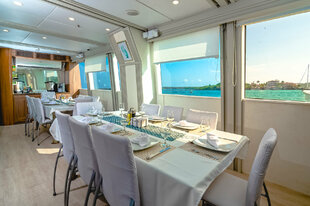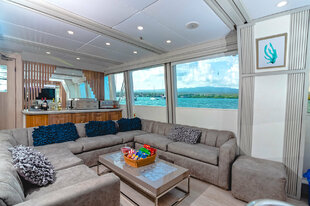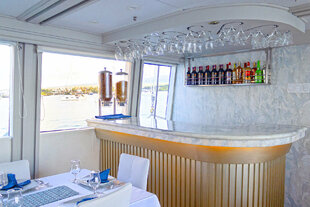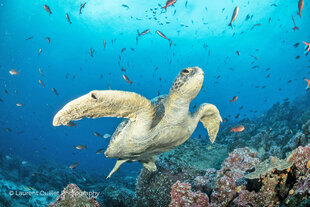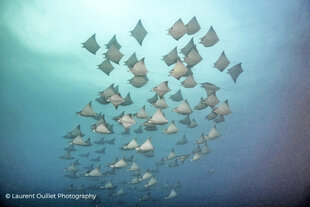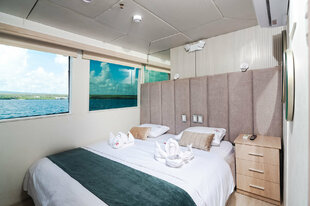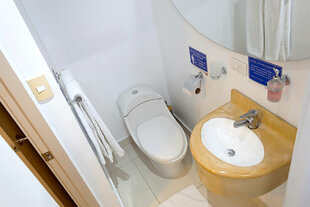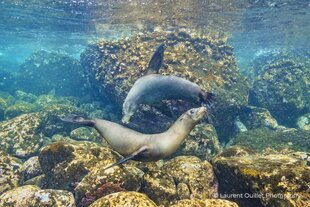Humboldt Explorer is a 16 passenger Galapagos dive liveaboard ship, renovated in 2023. Onboard are 8 air-conditioned ensuite cabins, each with a TV and ocean view – cabins 3 & 4 are twin with side-by-side beds while all other cabins can be converted between a twin layout or be drawn together to create a queen size double.
The boat also has many social areas for you to enjoy between activities, including a partially covered sun deck with a hot tub, sun loungers, seating, an alfresco dining area and a bar. To accommodate diving equipment, she also has a large dive deck featuring a large camera table, complete with charging station, personal storage areas and rinse bins for cameras and other gear. Diving operations are conducted from two large pangas (tenders) which can be easily boarded from the dive deck.
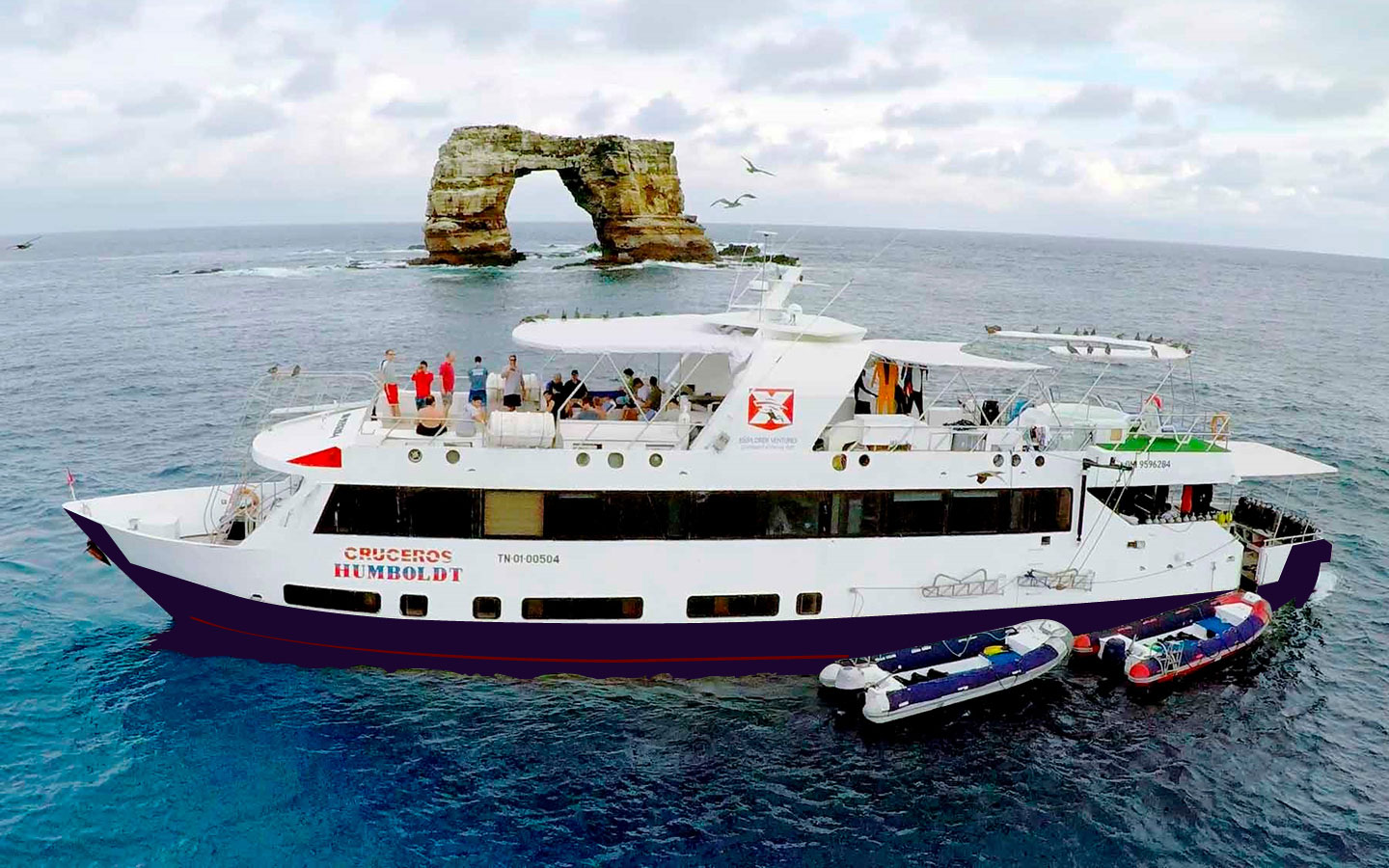
There are 3 diving itineraries (an 8 day / 7 night and two 11 day / 10 nights) offered on the Humboldt Explorer, each with slightly different routes. Included in prices are up to 4 dives per day, 3 meals on all days but Sunday (evening meal not included), snacks, towels, linens, tanks, weights, weight belts, air fills, transfers within Galapagos Islands for same-day arrivals and departures, local alcohol and non-alcoholic drinks.
Single travellers can book twin cabins on a sharing basis with a passenger of the same gender to avoid single supplement.
Diving, Wildlife & Photography
The primary focus of the trips offered on this boat is diving with marine life in the Galapagos. You will be swimming in the waters of Wolf and Darwin Islands, known for their abundance of sharks like Hammerheads and White-Tips – even Whale Sharks in the right season. It is also common to see Turtles, schools of Tuna, Eagle Rays and Sealions.
There are plenty of opportunities for underwater photographers on these itineraries, not only for marine life already mentioned, but also of complex and unique underwater rock formations and for macro photographers, with opportunities for shots of Sea Horses, Barnacle Blennies and Coral Hawkfish among others.
Although the diving in the Galapagos gives a brilliant experience of the archipelago, there are many opportunities to explore more of the islands above the water. This ship does include some activities above water but if you would like to explore more of the Galapagos Islands through land-based excursions, you could consider adding more time to your stay by choosing an experience from our Galapagos page.
Technical Specifications
| Length | 34 m / 111.5 ft |
| Beam | 6.5 m / 21.3 ft |
| Draft | 2.5 m / 8.2 ft |
| Tonnage | 169 ITC |
| Top speed | 10 knots |
| Fuel capacity | 5,300 gallons / 20,000 L |
| Guest capacity | Maximum 16 |
| Crew onboard | 7 & 2 guides |
| Air systems | 2 × Bauer compressors with Nitrox membrane (32% Nitrox) |
| Engines | Detroit diesel 6V92 350 HP |
| Generators | 2 × Perkins 73 kW |
| Safety equipment | 2 × life rafts, life rings, life vests, emergency position locator, flares & oxygen & first aid equipment |
| Tenders | 2 × rigid hull inflatables used for passenger transport & diver pickup |
Deck Plan
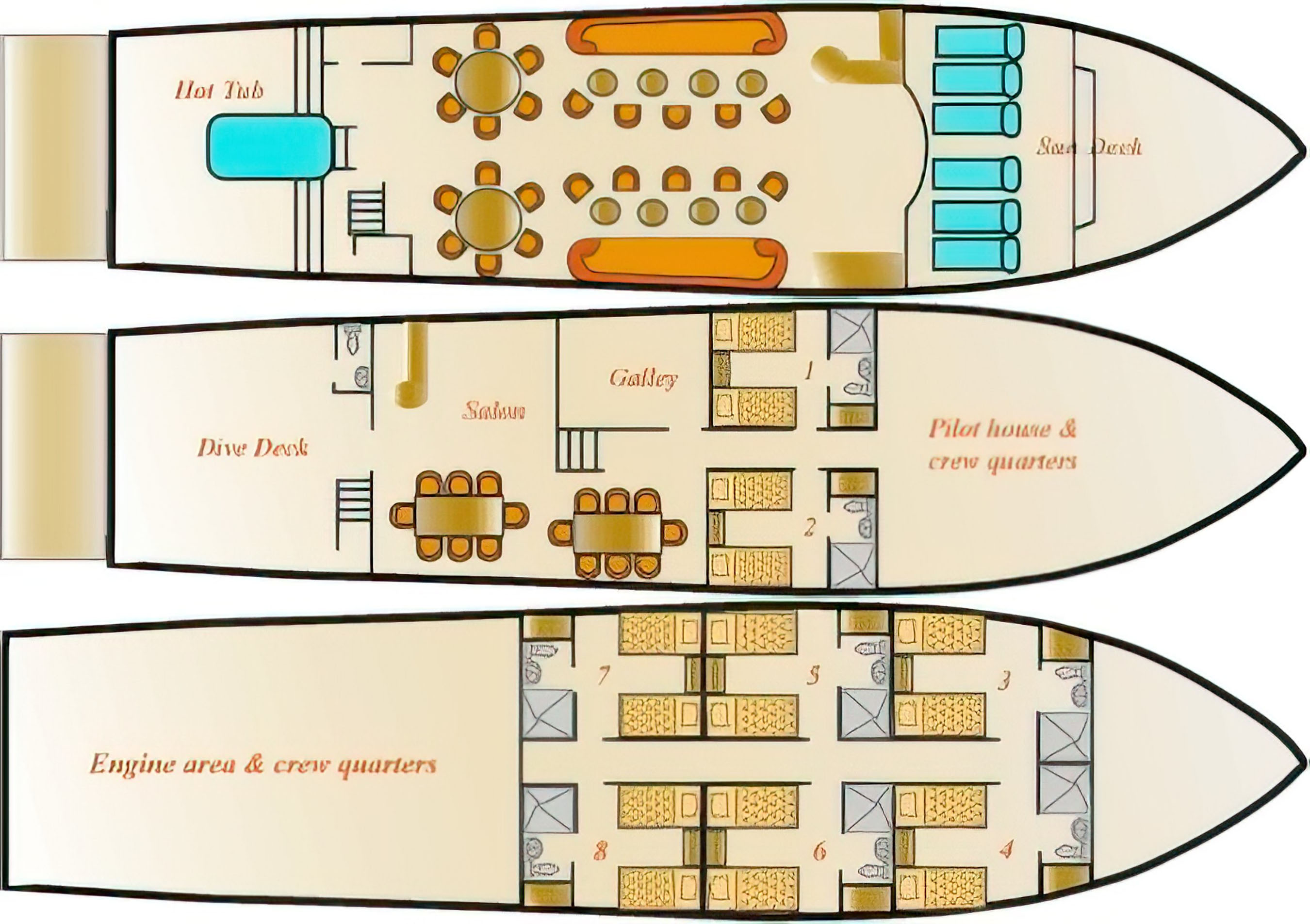
Itinerary
Please note that these itineraries are subject to change without notice due to seasonal changes, last minute weather conditions and the decision of the Galapagos National Park authority.
Itinerary A (8 days / 7 nights)
Day 1 (Monday) – Arrival
AM: Arrival, Baltra Island
Upon arrival Baltra, travellers pass through an airport inspection point to make sure that no foreign plants or animals are introduced to the islands, and to pay the park entrance fee of $200 (unless it has been prepaid). A guide will meet you, help you collect your luggage and escort you on a short bus ride to the harbour.
Day 2 (Tuesday) – North Seymour
AM: North Seymour Island
Today you will have an equipment check and 2 dives.
North Seymour is an uplifted island of lava flow lying just to the north of Santa Cruz Island. There are five dive sites here suitable for all levels of divers, although sometimes the currents can be strong. There is a considerable variety of species here. We can see cleaning behaviour, a large garden eel colony, sea turtles, sea lions, fur seals, eagle rays, yellow-tailed grunts, big-eyed jack, and frequently white tip reef sharks. Occasionally, Hammerheads and Galapagos Sharks can also be seen here. Beautiful blue nudibranchs can be found on some rocks in great abundance. Don't be surprised if a sealion appears before you beneath the water. Better still, we often anchor in a bay between dives where snorkelling with sealions often excellent, with long and playful encounters. All this whilst beside us is a rocky cliff covered in sea birds such as blue footed boobies.
PM: North Seymour Island Hiking
After your dives, you will walk the islet. North Seymour is teeming with birdlife. An easy circular path takes you through the archipelago’s most extensive colonies of blue-footed boobies and frigate birds. At the beginning of the breeding season, adult frigatebird-males blow up their vivid red pouches (gulas) to impressive football-sized balloons. This is one of the few spots where you can compare the magnificent and the great frigatebird breeding next to each other.
You are likely to come across several land iguanas on North Seymour and the coast can be a good place to spot Galapagos sealions.
In the evening, the ship will begin its long transit to Wolf Island for the next stages of the itinerary.
Day 3 (Wednesday) – Wolf Island
You will have 3 daytime dives at various dive sites around Wolf Island and a possible night dive.
Wolf Island is one of our planet’s most incredible dive locations. It is actually made up of two volcanic islands with a sheltered bay which you might share with a Sea Shepherd monitoring boat.
This is a good spot to see Red-Lipped Batfish which 'walk' along the seabed.
Wolf Island itself is one of the best places in the world to dive amongst sharks. This includes schooling hammerheads, Galapagos sharks, silky sharks, white tip sharks amongst the cliffs and caverns and sometimes whale sharks. Spotted eagle rays are another delight here and huge numbers of fish filling the water.
The dive sites at Wolf Island are listed below though you may not visit all of these over the week.
Anchorage, Wolf Island (Night Dive)
Anchorage is the only dive site located on the west coast of Wolf Island. Here, the strange walking Red-Lipped Batfish can be seen 20 m (70 ft) deep on the seabed. Though this animal is mainly active at night and is attracted by your diving lights, this probably won’t be your only time seeing it.
La Banana, Wolf Island
La Banana, also known as North Islet, has a sheer wall whose shape resembles that of a banana and is dotted with caverns, tunnels and other interesting rock formations. This dive site normally has great visibility and equally good marine life, with highlights including Galapagos Sharks, Hammerheads, Manta Rays and Green Turtles.
La Ventana Islets, Wolf Island
At La Ventana Islet (Window Islet in English), there is diverse marine life. One of the biggest highlights here is the Red-Lipped Batfish, which walk around on the sea floor. Hiding in and swimming around the complex rock formations are many other sea creatures, such as Moray Eels, Barracuda, Dolphins, White-Tip Sharks and Hammerheads. Whale Sharks can even be seen here between May and November.
Shark Bay, Wolf Island
Shark Bay is on the east side of Wolf Island and is shallower than most other sites around it but one of the most memorable due to high Whale Shark traffic which gave the site its name. There are also local cleaning stations here where you can see visiting Hawksbill & Pacific Green Turtles.
The Landslide, Wolf Island
This is one of the best dive sites of Wolf Island, with hundreds of Hammerhead Sharks circling around or heading against the current in some seasons. This drift diving site follows a boulder slope underneath the partly collapsed east cliffs of the islet leading to a hangout between the boulders where you can see Requiem Sharks, pelagic schools. In hotter seasons, Pacific Green Turtles, Spotted Eagle Rays and, sometimes, Mobula Devil Rays and Giant Oceanic Mantas can be seen here too.
The Pinnacle & the Caves, Wolf Island
At this site are some of the archipelago’s most interesting caves. Located north of Wolf Island, there are 4 main caves which penetrate the pinnacle, normally easily accessible with cave entrances at 15-21 m (50-70 ft). A sandy ledge runs along the wall beneath the entrances to each cave, where it is possible to see Hawksbill and Green Turtles gathering, schools of Soldierfish, Guineafowl Puffers, Moray Eels, Whitetop Reef Sharks, Marble Rays, Cardinalfish and Lobsters. If you have time, the cave with the largest opening can be interesting to explore. The dive here ends in the northeast corner of Wolf at a large underwater pinnacle ending just below the water’s surface. If the currents allow, you can hold on to the pinnacle and watch the marine life visible from it.
The Secret Cave, Wolf Island (Night Dive)
This dive site was formed by the collapse of large gas chambers dating back to the formation of Wolf. Along the walls which are sometimes surrounded by Hammerheads, there is an entrance to a cave with several nocturnal species like Cardinalfish, Spiny Lobsters, Shrimp, Sea Urchins, hunting Moral Eels, Pacific Green Turtles and Sea Lions.
Day 4 (Thursday) – Wolf Island & Darwin Island
AM: Wolf Island
You will have 2 morning dives at Wolf Island before beginning the transit to Darwin Island.
PM: Darwin Island
There will be 2 dives in the afternoon at Darwin Island on day 4.
Darwin Island is a high, relatively flat-topped island which is impossible to land on since it is sheer cliff all around. Thousands of birds live on the island, including Nazca Boobies and Frigate Birds. In addition to the island, Darwin's Pillars (formerly an arch) is a dramatic feature offshore; and many of your dives will be close to this point. Again, it is impossible to land here safely, but there is a colony of sealions which you will see from a distance living beneath the Arch.
The marine life is usually spectacular here with many sharks, especially hammerheads, which can swim very close. There are also lots of Porites coral bommies, so please avoid touching these. Between June and October / November, you will have good chances of seeing whale sharks here, including some huge females measuring up to about 15 metres.
There are many locations here for diving, listed below, but you may not visit all of these over the week.
Arco de Darwin
Darwin’s Arch, now a pillar formation since the arch collapsed in 2021, is one of the Galapagos’ most iconic locations. The shallow reef platforms around the landmark make this a great diving spot for seeing schools of Scalloped Hammerheads. Whale Sharks can also be seen here, mostly between June and November, with females making a stop-off during their solitary migrations.
Darwin’s Theatre
This dive site is where two forked ridges pointing northeast and southeast from the reef foundation of Darwin’s Arch. Curved shelves bending around the northern branch give the appearance of a grandstand with panoramic hangouts at around 18 m / 60 ft, giving the dive site its name. There is often swarming marine life here, with Hammerhead, Requiem and Silky Sharks, Yellow-Fin Tuna, Wahoos, Bonitos, Amberjacks and large schools of fish often being common sights here.
El Arenal
This dive site brings you close to the cleaning stations of Darwin Island, where Sharks, Turtles and Jacks regularly visit to be freed from parasites by the resident Barber Fish and King Angelfish. The busiest area here is the sandy slope in front of El Arenal portal. When the surge isn’t too strong, being dropped off here allows you to come face-to-face with Scalloped Hammerheads and resting Pacific Green and Hawksbill Turtles. As you swim further out, you can see the sloping shelves of rubble dropping into a deep gully, with the upper edges offering hideouts for Hammerheads. Other highlights here, depending on the season, include Whale Sharks, Bottlenose Dolphins, Mobula and Devil Rays and Giant Oceanic Mantas.
Day 5 (Friday) – Darwin Island
There will be a further 4 dives at sites around Darwin Island today – 2 in the morning and 2 in the afternoon.
Day 6 (Saturday) – Wolf Island
You will get a further 3 dives at Wolf Island, all in the morning, before beginning the 20+ hour transit to Cousins Rock. During this time, you can make use of the relaxation spaces and entertainment facilities onboard, such as looking out for wildlife on the sundeck as you move through the archipelago.
Day 7 (Sunday) – Cousins Rock & Highlands / Ayora Port / Darwin Station
AM: Cousins Rock, Santiago Island
You will have 1 or 2 dives at Cousin’s Rock on your 7th day of the liveaboard depending on when you arrive from your long transit. Cousin’s Rock dive site is characterised by its sloping rock formation which is home to many reef-dwelling marine animals such as Seahorses, Octopus, Sharks, Sea Lions and Green Turtles.
PM: Highlands, Puerto Ayora & Charles Darwin Research Station, Santa Cruz Island
Lunch will be served as you transit to Santa Cruz where you will visit the Highlands by bus. The road to the highlands leaves from Bellavista, a small village located a 15-minute drive from Santa Cruz’ main town of Puerto Ayora. The road passes through the Galapagos’ most productive agricultural zone, up to the National Park boundary. We find Miconia vegetation at this altitude, changing to the Fern and Sedge zone as we ascend further. With clear weather, we can enjoy beautiful scenes of rolling hills and extinct volcanic cones covered with grass and lush greenery all year round. In the Highlands, you will be able to see Galapagos Giant Tortoises as they graze in freshwater ponds and there will be a diversity of birdlife rarely found in the lowlands.
After the Highlands visit, you will go to Puerto Ayora and Charles Darwin Research Station independently.
Puerto Ayora is the largest and most developed town in the Galapagos Archipelago. There are countless opportunities for food and gift shopping here and the town is even home to the Charles Darwin Foundation and the Galapagos National Park. Tortuga Bay is easily accessible from the town where you can see Marine Iguanas, Galapagos Crabs, White-Tip Reef Sharks and the Galapagos Tortoise.
Although the great majority of Galapagos visitors come to the Charles Darwin Research Station to observe and appreciate natural wonders, it is also interesting to learn how the protection and conservation of the islands are carried out. The main attractions are the National Park information centre, the Van Staelen Exhibition Hall, the Breeding and Rearing Centre for young tortoises, and adult Galapagos tortoises in captivity.
You will have your own dinner in the town in the evening before returning to the boat at 8:30 pm. This is not included in the trip price.
Day 8 (Monday) – Departure
AM: Departure, Baltra Island
Your guide & some crew members will go with you to Baltra where you will board the airport shuttle. Your guide will remain with you through the check-in counters & departure hall.
Itinerary B (11 days / 10 nights)
Day 1 (Monday) – Arrival
AM: Arrival, Baltra Island
Upon arrival Baltra, travellers pass through an airport inspection point to make sure that no foreign plants or animals are introduced to the islands, and to pay the park entrance fee of $200 (unless it has been prepaid). A guide will meet you, help you collect your luggage and escort you on a short bus ride to the harbour. On boarding the boat, you will be given lunch and briefings about the boat and trip.
Day 2 (Tuesday) – North Seymour
AM: North Seymour Island Dives
There will be 2 dives in North Seymour today.
North Seymour is an uplifted island of lava flow lying just to the north of Santa Cruz Island. There are five dive sites here suitable for all levels of divers, although sometimes the currents can be strong. There is a considerable variety of species here. We can see cleaning behaviour, a large garden eel colony, sea turtles, sea lions, fur seals, eagle rays, yellow-tailed grunts, big-eyed jack, and frequently white tip reef sharks. Occasionally, Hammerheads and Galapagos Sharks can also be seen here. Beautiful blue nudibranchs can be found on some rocks in great abundance. Don't be surprised if a sealion appears before you beneath the water. Better still, we often anchor in a bay between dives where snorkelling with sealions often excellent, with long and playful encounters. All this whilst beside us is a rocky cliff covered in sea birds such as blue footed boobies.
PM: North Seymour Island Hike
North Seymour is teeming with birdlife. An easy circular path takes you through the archipelago’s most extensive colonies of blue-footed boobies and frigate birds. At the beginning of the breeding season, adult frigatebird-males blow up their vivid red pouches (gulas) to impressive football-sized balloons. This is one of the few spots where you can compare the magnificent and the great frigatebird breeding next to each other.
You are likely to come across several land iguanas on North Seymour and the coast can be a good place to spot Galapagos sealions.
In the evening, the boat will begin its long transit to Wolf Island for the next stages of your itinerary.
Day 3 (Wednesday) – Wolf
Today, there will be a morning dive and 2 afternoon dives at Wolf Island.
Wolf Island is one of our planet’s most incredible dive locations. It is actually made up of two volcanic islands with a sheltered bay which you might share with a Sea Shepherd monitoring boat.
This is a good spot to see Red-Lipped Batfish which 'walk' along the seabed.
Wolf Island itself is one of the best places in the world to dive amongst sharks. This includes schooling hammerheads, Galapagos sharks, silky sharks, white tip sharks amongst the cliffs and caverns and sometimes whale sharks. Spotted eagle rays are another delight here and huge numbers of fish filling the water.
If conditions are good, there may also be a night dive. There are many dive spots around Wolf Island, not all of which you will be able to visit over the week. The dive sites there are listed below.
Anchorage (Night Dive)
Anchorage is the only dive site located on the west coast of Wolf Island. Here, the strange walking Red-Lipped Batfish can be seen 20 m (70 ft) deep on the seabed. Though this animal is mainly active at night and is attracted by your diving lights, this probably won’t be your only time seeing it.
La Banana
La Banana, also known as North Islet, has a sheer wall whose shape resembles that of a banana and is dotted with caverns, tunnels and other interesting rock formations. This dive site normally has great visibility and equally good marine life, with highlights including Galapagos Sharks, Hammerheads, Manta Rays and Green Turtles.
La Ventana Islets
At La Ventana Islet (Window Islet in English), there is diverse marine life. One of the biggest highlights here is the Red-Lipped Batfish, which walk around on the sea floor. Hiding in and swimming around the complex rock formations are many other sea creatures, such as Moray Eels, Barracuda, Dolphins, White-Tip Sharks and Hammerheads. Whale Sharks can even be seen here between May and November.
Shark Bay
At La Ventana Islet (Window Islet in English), there is diverse marine life. One of the biggest highlights here is the Red-Lipped Batfish, which walk around on the sea floor. Hiding in and swimming around the complex rock formations are many other sea creatures, such as Moray Eels, Barracuda, Dolphins, White-Tip Sharks and Hammerheads. Whale Sharks can even be seen here between May and November.
The Landslide
This is one of the best dive sites of Wolf Island, with hundreds of Hammerhead Sharks circling around or heading against the current in some seasons. This drift diving site follows a boulder slope underneath the partly collapsed east cliffs of the islet leading to a hangout between the boulders where you can see Requiem Sharks, pelagic schools. In hotter seasons, Pacific Green Turtles, Spotted Eagle Rays and, sometimes, Mobula Devil Rays and Giant Oceanic Mantas can be seen here too.
The Pinnacle & the Caves
At this site are some of the archipelago’s most interesting caves. Located north of Wolf Island, there are 4 main caves which penetrate the pinnacle, normally easily accessible with cave entrances at 15-21 m (50-70 ft). A sandy ledge runs along the wall beneath the entrances to each cave, where it is possible to see Hawksbill and Green Turtles gathering, schools of Soldierfish, Guineafowl Puffers, Moray Eels, Whitetop Reef Sharks, Marble Rays, Cardinalfish and Lobsters. If you have time, the cave with the largest opening can be interesting to explore. The dive here ends in the northeast corner of Wolf at a large underwater pinnacle ending just below the water’s surface. If the currents allow, you can hold on to the pinnacle and watch the marine life visible from it.
The Secret Cave (Night Dive)
This dive site was formed by the collapse of large gas chambers dating back to the formation of Wolf. Along the walls which are sometimes surrounded by Hammerheads, there is an entrance to a cave with several nocturnal species like Cardinalfish, Spiny Lobsters, Shrimp, Sea Urchins, hunting Moral Eels, Pacific Green Turtles and Sea Lions.
Day 4 (Thursday) – Wolf & Darwin
AM: Wolf Island
You will have 2 morning dives at Wolf Island before beginning your transit to Darwin Island
PM: Darwin Island
You will have 2 afternoon dives at dive sites around Darwin Island.
Darwin Island is a high, relatively flat-topped island which is impossible to land on since it is sheer cliff all around. Thousands of birds live on the island, including Nazca Boobies and Frigate Birds. In addition to the island, Darwin's Pillars (formerly an arch) is a dramatic feature offshore; and many of your dives will be close to this point. Again, it is impossible to land here safely, but there is a colony of sealions which you will see from a distance living beneath the Arch.
The marine life is usually spectacular here with many sharks, especially hammerheads, which can swim very close. There are also lots of Porites coral bommies, so please avoid touching these. Between June and October / November, you will have good chances of seeing whale sharks here, including some huge females measuring up to about 15 metres.
The different dive sites here are listed below but you might not visit all of these over the week.
Arco de Darwin
Darwin’s Arch, now a pillar formation since the arch collapsed in 2021, is one of the Galapagos’ most iconic locations. The shallow reef platforms around the landmark make this a great diving spot for seeing schools of Scalloped Hammerheads. Whale Sharks can also be seen here, mostly between June and November, with females making a stop-off during their solitary migrations.
Darwin’s Theatre
This dive site is where two forked ridges pointing northeast and southeast from the reef foundation of Darwin’s Arch. Curved shelves bending around the northern branch give the appearance of a grandstand with panoramic hangouts at around 18 m / 60 ft, giving the dive site its name. There is often swarming marine life here, with Hammerhead, Requiem and Silky Sharks, Yellow-Fin Tuna, Wahoos, Bonitos, Amberjacks and large schools of fish often being common sights here.
El Arenal
This dive site brings you close to the cleaning stations of Darwin Island, where Sharks, Turtles and Jacks regularly visit to be freed from parasites by the resident Barber Fish and King Angelfish. The busiest area here is the sandy slope in front of El Arenal portal. When the surge isn’t too strong, being dropped off here allows you to come face-to-face with Scalloped Hammerheads and resting Pacific Green and Hawksbill Turtles. As you swim further out, you can see the sloping shelves of rubble dropping into a deep gully, with the upper edges offering hideouts for Hammerheads. Other highlights here, depending on the season, include Whale Sharks, Bottlenose Dolphins, Mobula and Devil Rays and Giant Oceanic Mantas.
Day 5 & 6 (Friday & Saturday) – Darwin
You will have 4 more dives around Darwin Island on each day – 2 in the morning and 2 in the afternoon.
Day 7 (Sunday) – Wolf
You will have 4 more dives at Wolf Island – 2 in the morning and 2 in the afternoon. After your dives, the ship will begin its long transit to Cabo Douglas. You can use this time to take advantage of the ship’s social spaces and entertainment facilities to relax. This would be a good opportunity to use the sun deck for wildlife sightings and viewing the landscapes across some of the archipelago.
Day 8 (Monday) – Cape Douglas, Isabela Island
There will be 2-3 dives at Cabo Douglas on today.
There is some great wildlife to see at Cape Douglas, including Flightless Cormorants, Galapagos Penguins and Marine Iguanas. Beneath the waves you can hope to see Red-Lipped Batfish, Galapagos Bullhead Sharks and Mola-Mola. It is sometimes possible to see baleen whales at this site too. Diving here should be great for Marine Iguana encounters, as well as underwater volcanic formations.
After diving here, the ship will make its transit to Punta Vicente Roca.
Day 9 (Tuesday) – Cape Marshall, Isabela Island
Day 9 brings 3-4 dives at Cape Marshall. Cape Marshall in on the north-east side of Isabela and is home to a few great diving spots. One of these is Ciudad de las Mantas, so named because Giant Mantas are a common sight here. The richness of the waters in this region makes it easy to spot much marine life, such as Rays, Sharks, Sea Lions, Turtles & more.
Next, the ship will transit to Cousins Rock.
Day 10 (Wednesday) – Cousins Rock & Highlands / Ayora Port
AM: Cousins Rock, Santiago Island
Cousin’s Rock dive site is characterised by its sloping rock formation which is home to many reef-dwelling marine animals such as Seahorses, Octopus, Sharks, Sea Lions and Green Turtles.
PM: Highlands & Puerto Ayora, Santa Cruz Highlands
The road to the highlands leaves from Bellavista, a small village located a 15-minute drive from Santa Cruz’ main town of Puerto Ayora. The road passes through the Galapagos’ most productive agricultural zone, up to the National Park boundary. We find Miconia vegetation at this altitude, changing to the Fern and Sedge zone as we ascend further. With clear weather, we can enjoy beautiful scenes of rolling hills and extinct volcanic cones covered with grass and lush greenery all year round. In the Highlands, you will be able to see Galapagos Giant Tortoises as they graze in freshwater ponds and there will be a diversity of birdlife rarely found in the lowlands.
Puerto Ayora is a town in the south of Santa Cruz Island and is the largest and most developed in the entire peninsula. There are countless opportunities for food and gift shopping here and the town is even home to the Charles Darwin Foundation and the Galapagos National Park. Tortuga Bay is easily accessible from the town where you can see Marine Iguanas, Galapagos Crabs, White-Tip Reef Sharks and the Galapagos Tortoise. The opportunities in the town make it well worth a visit. You will eat dinner here on your own before returning to the ship at 8:30pm.
Day 11 (Thursday) – Departure
AM: Departure, Baltra Island
Your guide & some crew members will go with you to Baltra where you will board the airport shuttle. Your guide will remain with you through the check-in counters & departure hall.
Itinerary C (11 days / 10 nights)
Day 1 (Friday) – Arrival
AM: Arrival, Baltra Island
Upon arrival Baltra, travellers pass through an airport inspection point to make sure that no foreign plants or animals are introduced to the islands, and to pay the park entrance fee of $200 (unless it has been prepaid). A guide will meet you, help you collect your luggage and escort you on a short bus ride to the harbour. On boarding the boat, you will be given lunch and briefings about the boat and trip.
Day 2 (Saturday) – North Seymour
AM: North Seymour Island Diving
North Seymour is an uplifted island of lava flow lying just to the north of Santa Cruz Island. There are five dive sites here suitable for all levels of divers, although sometimes the currents can be strong. There is a considerable variety of species here. We can see cleaning behaviour, a large garden eel colony, sea turtles, sea lions, fur seals, eagle rays, yellow-tailed grunts, big-eyed jack, and frequently white tip reef sharks. Occasionally, Hammerheads and Galapagos Sharks can also be seen here. Beautiful blue nudibranchs can be found on some rocks in great abundance. Don't be surprised if a sealion appears before you beneath the water. Better still, we often anchor in a bay between dives where snorkelling with sealions often excellent, with long and playful encounters. All this whilst beside us is a rocky cliff covered in sea birds such as blue footed boobies.
PM: North Seymour Island Hiking
North Seymour is also teeming with birdlife. An easy circular path takes you through the archipelago’s most extensive colonies of blue-footed boobies and frigate birds. At the beginning of the breeding season, adult frigatebird-males blow up their vivid red pouches (gulas) to impressive football-sized balloons. This is one of the few spots where you can compare the magnificent and the great frigatebird breeding next to each other.
You are likely to come across several land iguanas on North Seymour and the coast can be a good place to spot Galapagos sealions.
The ship will begin its transit north, giving you the opportunity to use the social areas and entertainment facilities onboard. You could enjoy spotting wildlife and observing the landscapes around from the sun deck as you cruise through the archipelago.
Day 3 (Sunday) – Cape Marshall, Isabela Island
Cape Marshall in on the north-east side of Isabela and is home to a few great diving spots. In these dive locations, it is easiest to drift dive across a black coral-coated vertical wall descending to the seabed where Hammerhead, White-Tipped & Galapagos sharks can be spotted. Even Whale Sharks have been seen here. Other marine life includes large schools of Black-Striped Salema and Barracuda.
Day 4 (Monday) – Vicente Roca Point & Cape Douglas
AM: Punta Vicente Roca, Isabela Island
You will have a morning dive in Vicente Roca Point.
There are great underwater opportunities at Vicente Roca Point thanks to upwelling cold-water currents here. Marine life in the area includes various shark species, Galapagos Penguins, Seahorses & Mola-Mola. Other animals which you can hope to see here are Nazca & Blue-Footed Boobies, Brown Pelicans & Flightless Cormorants. A Panga ride after your dive will give you the site’s best opportunities for photographing Galapagos Penguins, Flightless Cormorants and Blue Footed Boobies.
PM: Cabo Douglas, Isabela Island
The afternoon will bring 1 or 2 dives at Cape Douglas.
There is some great wildlife to see at Cape Douglas, including Flightless Cormorants, Galapagos Penguins and Marine Iguanas. Beneath the waves you can hope to see Red-Lipped Batfish, Galapagos Bullhead Sharks and Mola-Mola. It is sometimes possible to see baleen whales at this site too. Diving here should be great for Marine Iguana encounters, as well as underwater volcanic formations.
Day 5 (Tuesday) – Darwin
You will have 3 dives at Darwin Island today.
Darwin Island is a high, relatively flat-topped island which is impossible to land on since it is sheer cliff all around. Thousands of birds live on the island, including Nazca Boobies and Frigate Birds. In addition to the island, Darwin's Pillars (formerly an arch) is a dramatic feature offshore; and many of your dives will be close to this point. Again, it is impossible to land here safely, but there is a colony of sealions which you will see from a distance living beneath the Arch.
The marine life is usually spectacular here with many sharks, especially hammerheads, which can swim very close. There are also lots of Porites coral bommies, so please avoid touching these. Between June and October / November, you will have good chances of seeing whale sharks here, including some huge females measuring up to about 15 metres.
There are a few dive sites here, listed below, but you might not visit them all over the week.
Arco de Darwin
Darwin’s Arch, now a pillar formation since the arch collapsed in 2021, is one of the Galapagos’ most iconic locations. The shallow reef platforms around the landmark make this a great diving spot for seeing schools of Scalloped Hammerheads. Whale Sharks can also be seen here, mostly between June and November, with females making a stop-off during their solitary migrations.
Darwin’s Theatre
This dive site is where two forked ridges pointing northeast and southeast from the reef foundation of Darwin’s Arch. Curved shelves bending around the northern branch give the appearance of a grandstand with panoramic hangouts at around 18 m / 60 ft, giving the dive site its name. There is often swarming marine life here, with Hammerhead, Requiem and Silky Sharks, Yellow-Fin Tuna, Wahoos, Bonitos, Amberjacks and large schools of fish often being common sights here.
El Arenal
This dive site brings you close to the cleaning stations of Darwin Island, where Sharks, Turtles and Jacks regularly visit to be freed from parasites by the resident Barber Fish and King Angelfish. The busiest area here is the sandy slope in front of El Arenal portal. When the surge isn’t too strong, being dropped off here allows you to come face-to-face with Scalloped Hammerheads and resting Pacific Green and Hawksbill Turtles. As you swim further out, you can see the sloping shelves of rubble dropping into a deep gully, with the upper edges offering hideouts for Hammerheads. Other highlights here, depending on the season, include Whale Sharks, Bottlenose Dolphins, Mobula and Devil Rays and Giant Oceanic Mantas.
Day 6 (Wednesday) – Wolf
You will dive 4 times at sites around Wolf Island – twice in the morning and twice in the afternoon.
Wolf Island is one of our planet’s most incredible dive locations. It is actually made up of two volcanic islands with a sheltered bay which you might share with a Sea Shepherd monitoring boat.
This is a good spot to see Red-Lipped Batfish which 'walk' along the seabed.
Wolf Island itself is one of the best places in the world to dive amongst sharks. This includes schooling hammerheads, Galapagos sharks, silky sharks, white tip sharks amongst the cliffs and caverns and sometimes whale sharks. Spotted eagle rays are another delight here and huge numbers of fish filling the water.
There are many dive sites here, listed below, but you might not visit them all by the end of the trip.
Anchorage (Night Dive)
Anchorage is the only dive site located on the west coast of Wolf Island. Here, the strange walking Red-Lipped Batfish can be seen 20 m (70 ft) deep on the seabed. Though this animal is mainly active at night and is attracted by your diving lights, this probably won’t be your only time seeing it.
La Banana
La Banana, also known as North Islet, has a sheer wall whose shape resembles that of a banana and is dotted with caverns, tunnels and other interesting rock formations. This dive site normally has great visibility and equally good marine life, with highlights including Galapagos Sharks, Hammerheads, Manta Rays and Green Turtles.
La Ventana Island
At La Ventana Islet (Window Islet in English), there is diverse marine life. One of the biggest highlights here is the Red-Lipped Batfish, which walk around on the sea floor. Hiding in and swimming around the complex rock formations are many other sea creatures, such as Moray Eels, Barracuda, Dolphins, White-Tip Sharks and Hammerheads. Whale Sharks can even be seen here between May and November.
Shark Bay
Shark Bay is on the east side of Wolf Island and is shallower than most other sites around it but one of the most memorable due to high Whale Shark traffic which gave the site its name. There are also local cleaning stations here where you can see visiting Hawksbill & Pacific Green Turtles.
The Landslide
This is one of the best dive sites of Wolf Island, with hundreds of Hammerhead Sharks circling around or heading against the current in some seasons. This drift diving site follows a boulder slope underneath the partly collapsed east cliffs of the islet leading to a hangout between the boulders where you can see Requiem Sharks, pelagic schools. In hotter seasons, Pacific Green Turtles, Spotted Eagle Rays and, sometimes, Mobula Devil Rays and Giant Oceanic Mantas can be seen here too.
The Pinnacle & the Caves
At this site are some of the archipelago’s most interesting caves. Located north of Wolf Island, there are 4 main caves which penetrate the pinnacle, normally easily accessible with cave entrances at 15-21 m (50-70 ft). A sandy ledge runs along the wall beneath the entrances to each cave, where it is possible to see Hawksbill and Green Turtles gathering, schools of Soldierfish, Guineafowl Puffers, Moray Eels, Whitetop Reef Sharks, Marble Rays, Cardinalfish and Lobsters. If you have time, the cave with the largest opening can be interesting to explore. The dive here ends in the northeast corner of Wolf at a large underwater pinnacle ending just below the water’s surface. If the currents allow, you can hold on to the pinnacle and watch the marine life visible from it.
The Secret Cave
This dive site was formed by the collapse of large gas chambers dating back to the formation of Wolf. Along the walls which are sometimes surrounded by Hammerheads, there is an entrance to a cave with several nocturnal species like Cardinalfish, Spiny Lobsters, Shrimp, Sea Urchins, hunting Moral Eels, Pacific Green Turtles and Sea Lions.
Day 7 (Thursday) – Wolf & Darwin
AM: Wolf Island
You will have 2 more dives at Wolf in the morning before transit to Darwin.
PM: Darwin Island
You will dive another 2 times at sites around Darwin Island.
Day 8 (Friday) – Darwin
You will have another 4 dives at various sites around Darwin Island – 2 in the morning and 2 in the afternoon.
Day 9 (Saturday) – Wolf
You will be back at Wolf Island today, where you will have 3 dives before transit to Cousins Rock.
Day 10 (Sunday) – Cousins Rock & Highlands / Ayora Port
On your last full day on the liveaboard, you will have 1 or 2 dives at Cousin’s Rock, a land visit to the Highlands of Santa Cruz and an evening trip to Puerto Ayora, where you will have dinner in the town.
AM: Cousins Rock, Santiago Island
Cousin’s Rock dive site is characterised by its sloping rock formation which is home to many reef-dwelling marine animals such as Seahorses, Octopus, Sharks, Sea Lions and Green Turtles.
PM: Highlands & Puerto Ayora, Santa Cruz Island
The road to the highlands leaves from Bellavista, a small village located a 15-minute drive from Santa Cruz’ main town of Puerto Ayora. The road passes through the Galapagos’ most productive agricultural zone, up to the National Park boundary. We find Miconia vegetation at this altitude, changing to the Fern and Sedge zone as we ascend further. With clear weather, we can enjoy beautiful scenes of rolling hills and extinct volcanic cones covered with grass and lush greenery all year round. In the Highlands, you will be able to see Galapagos Giant Tortoises as they graze in freshwater ponds and there will be a diversity of birdlife rarely found in the lowlands.
Puerto Ayora is a town in the south of Santa Cruz Island and is the largest and most developed in the entire peninsula. There are countless opportunities for food and gift shopping here and the town is even home to the Charles Darwin Foundation and the Galapagos National Park. Tortuga Bay is easily accessible from the town where you can see Marine Iguanas, Galapagos Crabs, White-Tip Reef Sharks and the Galapagos Tortoise. The opportunities in the town make it well worth a visit. You will dine by yourself in town tonight before returning to the boat for 8:30pm.
Day 11 (Monday) – Departure
AM: Departure, Baltra Island
Your guide & some crew members will go with you to Baltra where you will board the airport shuttle. Your guide will remain with you through the check-in counters & departure hall.
Dates
Diving Itinerary A (8 days / 7 nights)
Diving Itinerary A (8 days / 7 nights)
Diving Itinerary A (8 days / 7 nights)
Diving Itinerary B (11 days / 10 nights)
Diving Itinerary A (8 days / 7 nights)
Special Shark & Photography with Dr Simon Pierce: Diving Itinerary A (8 days / 7 nights)
Diving Itinerary A (8 days / 7 nights)
Diving Itinerary A (8 days / 7 nights)
Included
All meals onboard
Between-dive snacks
Towels, linens, etc.
Use of tanks, weights & weight belts
Air fills
Transfers within the Galapagos
Local alcohol & non-alcoholic beverages
Not included
Galapagos National Park entrance fee ($200)
Chamber Support fee ($35)
Tourist card ($20)
Fuel surcharge
Airfare to Galapagos Islands
Local taxes
Single Supplement
Cabins can be booked for single occupants for an 80% increase on shared cabin price.


